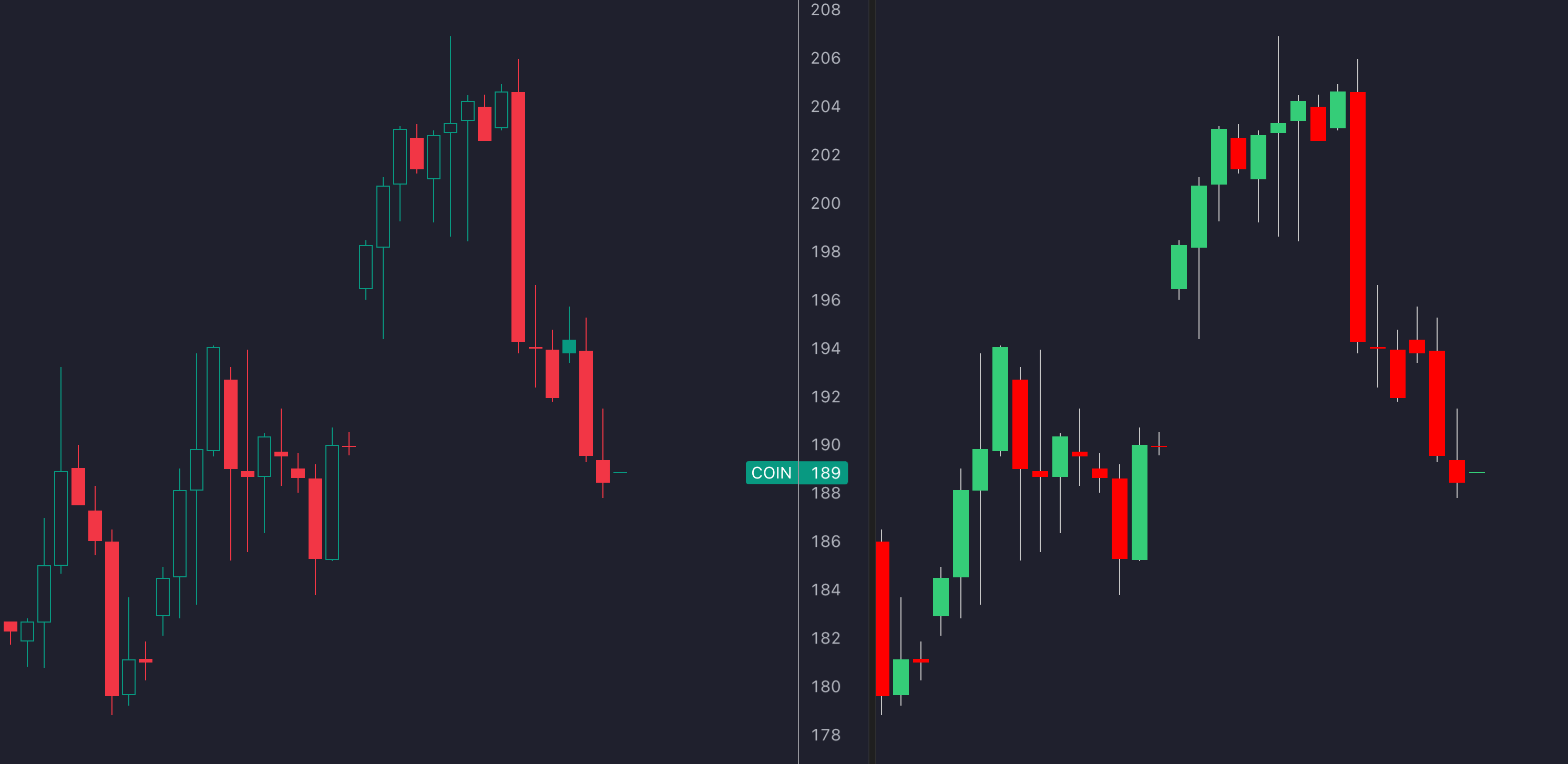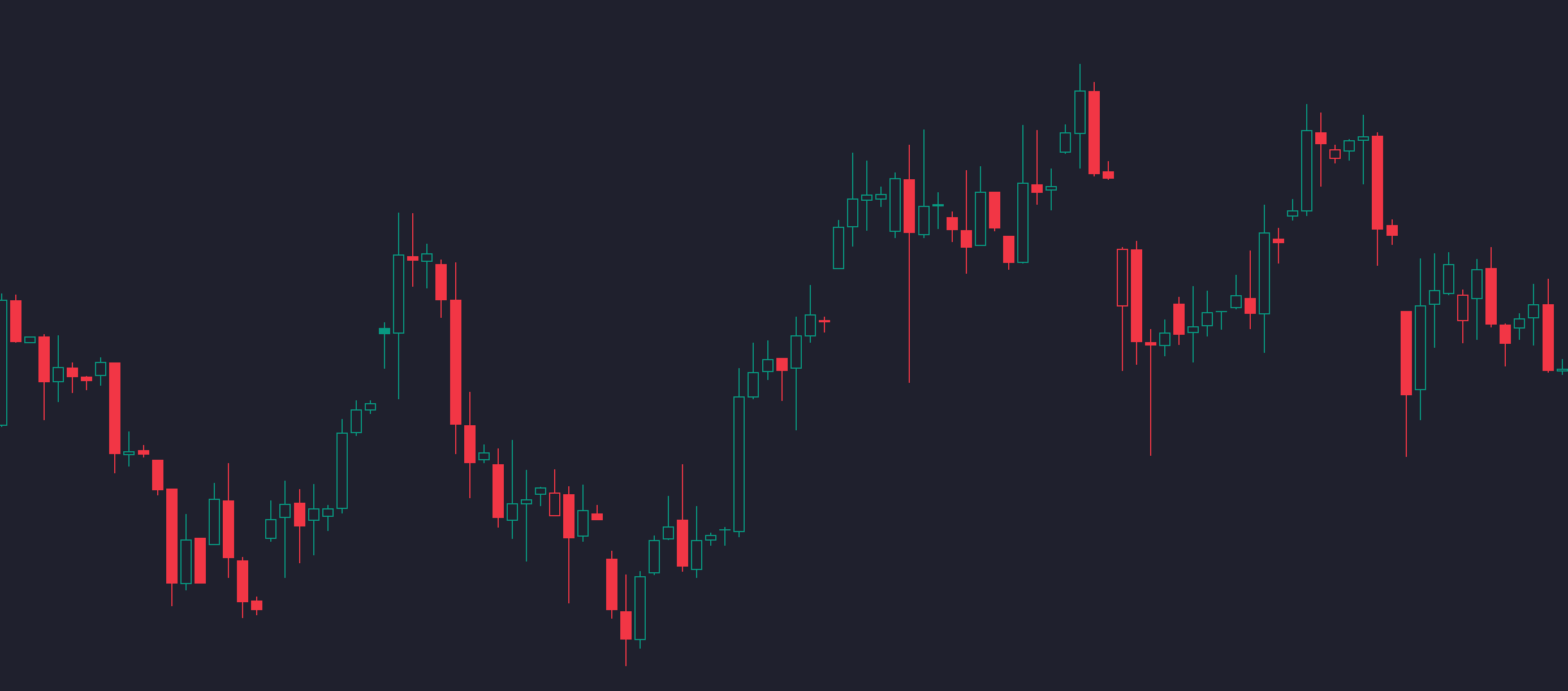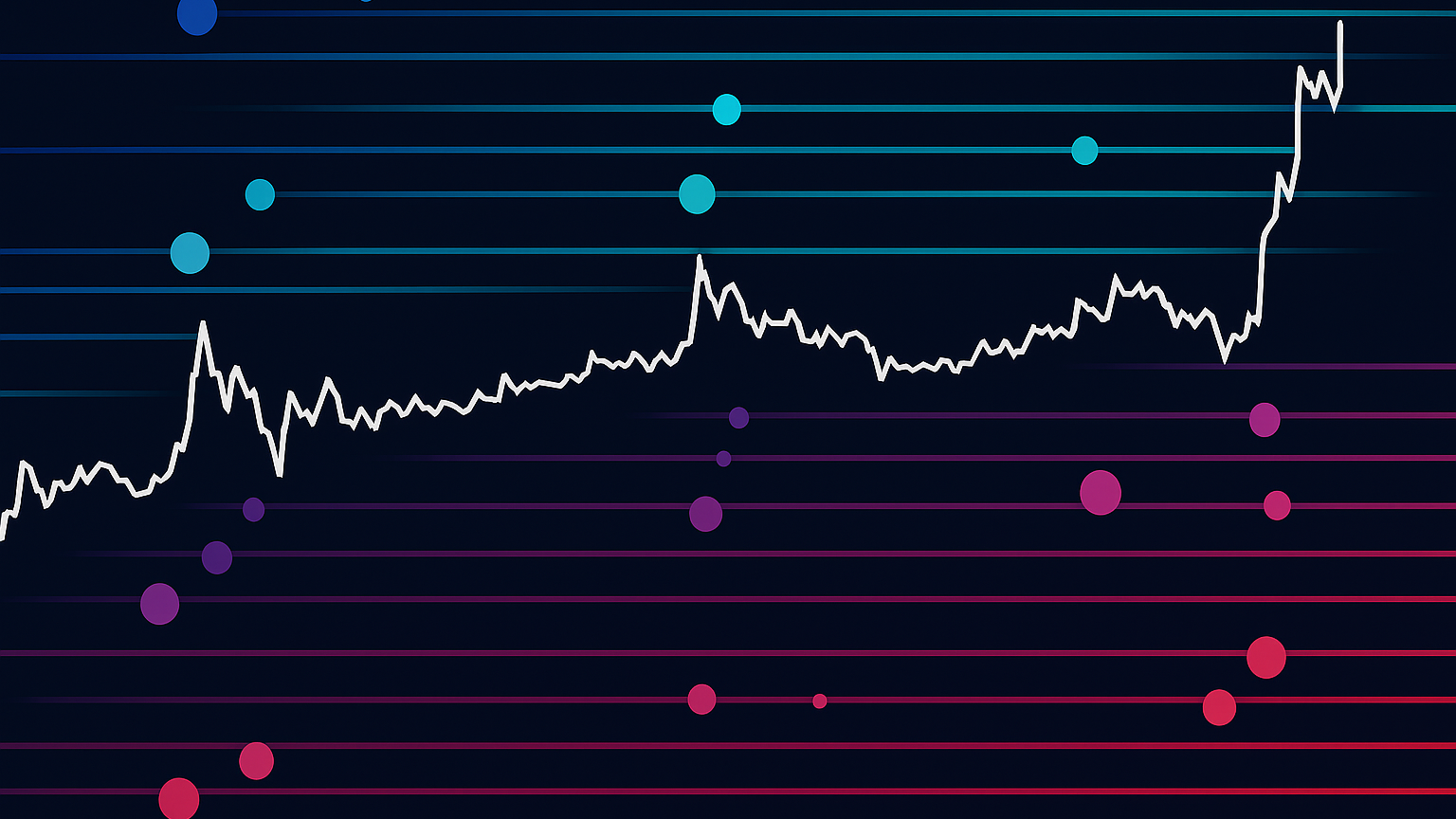Explore the power of hollow candles in trading, highlighting market trends, momentum, and reversal signals for better decision-making.
Hollow candles offer a visually clear way to understand market trends and momentum by combining color and fill patterns. Here's what you need to know:
-
Hollow Candles Basics:
- Hollow: Close > Open (bullish).
- Filled: Close < Open (bearish).
- Color: Green/White = Higher close than previous; Red/Black = Lower close than previous.
-
Why Use Them?:
- Easy trend identification.
- Highlights market momentum.
- Simplifies support/resistance level analysis.
-
Key Benefits:
- Four signals: Green/White Hollow (strong bullish), Red/Black Hollow (moderate bullish), Green/White Filled (moderate bearish), Red/Black Filled (strong bearish).
- Works well with advanced solutions from LuxAlgo on TradingView for confirmation.
Hollow candles are perfect for traders seeking a simpler yet detailed way to analyze price movements and market sentiment. Keep reading to learn how to use them effectively in your trading strategy.
Hollow Candle Structure
Parts of a Hollow Candle
A hollow candle consists of two main parts: the rectangular body and the wicks (also called shadows). The body shows the opening and closing prices for a specific time period, while the wicks represent the highest and lowest prices reached during that same period.
Here’s a quick breakdown of what each component indicates:
| Component | Represents | Meaning |
|---|---|---|
| Fill | Relationship between open and close | Hollow = Close > Open; Filled = Close < Open |
| Color | Comparison to previous close | Green/White = Higher; Red/Black = Lower |
Hollow vs. Filled Candles Explained

Hollow candles occur when the closing price is higher than the opening price, signaling buying pressure. On the other hand, filled candles appear when the closing price is lower than the opening price, signaling selling pressure.
"Hollow candles can provide traders with a more accurate and intuitive view of market sentiment and trends than traditional Japanese candlesticks."
Differences from Standard Candlesticks
Hollow candles stand apart from traditional candlesticks in a few key ways:
| Feature | Hollow Candles | Traditional Candlesticks |
|---|---|---|
| Color Meaning | Compares the current close to the previous close | Shows whether the current close is above or below the open |
| Fill Usage | Highlights price direction within the current period | Uses a solid body without fill variations |
| Trend Visibility | Combines color and fill to show momentum | Relies solely on color to indicate trends |
"Hollow candlesticks give you a new way to see more information on a trading chart and to perceive when a bullish or bearish trend is forming based on a combination of hollow or filled candles and as you know, the more information we get when we trade then the better off are we!"
Traders can identify strong market momentum by observing consecutive hollow or filled candles. For example, a series of long hollow candles indicates strong buying pressure, while a string of long filled candles points to strong selling pressure.
These features provide a clearer view of market dynamics, setting the foundation for deeper analysis in the next section.
How To Read A Hollow Candle Chart
Reading Hollow Candles
Let's break down how hollow candles can provide insights into market trends and trading opportunities.
Up and Down Market Signals
Hollow candles offer two key visual clues: fill and color. A hollow candle means the closing price is higher than the opening price, while a filled candle means the closing price is lower than the opening price. The color reflects how the current close compares to the previous candle's close: green/white indicates a higher close, while red/black signals a lower close.
| Signal Type | Fill | Color | Market Indication |
|---|---|---|---|
| Most Bullish | Hollow | Green/White | Strong upward momentum |
| Bullish | Hollow | Red/Black | Moderate upward movement |
| Bearish | Filled | Green/White | Moderate downward movement |
| Most Bearish | Filled | Red/Black | Strong downward momentum |
When viewed together, these signals provide a clearer picture of market momentum.
Analyzing Multiple Candles
Looking at patterns across multiple candles can reveal trends. For example, a series of hollow candles with long bodies and short wicks, combined with steady upward movement, points to strong buying pressure. On the flip side, consecutive filled candles with similar characteristics suggest ongoing selling pressure and a likely continuation of a downward trend.
Using Other Technical Tools
Hollow candles work even better when paired with additional technical indicators. These complementary methods help verify signals, reduce the chance of false readings, and pinpoint critical support or resistance levels—giving you a more well-rounded view of the market.
Trading with Hollow Candles
This section dives into how hollow candles can be directly applied in trading strategies.
Identifying Market Trends
Hollow candles make it easier to spot trends by using their fill and color patterns. For example, a series of hollow candles with long bodies and short wicks often points to strong buying pressure and a steady upward trend. Simply put, hollow candles generally indicate bullish conditions, while filled candles suggest bearish ones.
They’re not just useful for spotting trends – they also help in identifying potential reversals.
Spotting Market Reversals
If a hollow candle appears after several filled candles near a support level, it might signal an upward reversal. On the flip side, a filled candle showing up after hollow candles near a resistance level could hint at a downward reversal. To confirm these signals, look for additional indicators like strong upward price movements or gaps accompanied by high trading volume.
Combining Advanced Solutions from LuxAlgo with Hollow Candles
For a more refined approach, consider pairing hollow candle analysis with advanced solutions from LuxAlgo on TradingView. Features such as EquiVolume, Liquidity Levels detection, and Reversal Signals can complement hollow candles—helping to confirm trends and filter out false signals.
This combination not only improves the accuracy of your analysis but also provides a fresh perspective compared to traditional candlestick charts. These solutions further enhance hollow candle strategies, making them a valuable part of your technical analysis.
Key Hollow Candle Patterns
Hollow candle patterns can provide traders with clear signals for entering and exiting the market. Let’s break down some of the key patterns and what they indicate.
Upward Market Patterns
The Three White Soldiers pattern consists of three consecutive rising hollow candles, often accompanied by higher trading volume. For example, this pattern was evident in PDVW's chart, signaling a potential bullish reversal. Another notable pattern is the Morning Star, which develops over three days: it begins with a large filled candle, followed by a smaller candle, and ends with a large hollow candle that closes above the midpoint of the first day's candle.
While these patterns suggest bullish trends, there are also clear indicators of bearish reversals.
Downward Market Patterns
The Solid Black Candle pattern often appears near new price highs during an uptrend. These candles reject intraday highs, signaling a potential bearish reversal.
Pattern Verification Methods
Identifying a pattern is just the first step – confirmation is crucial before making a trade.
"The patterns themselves do not guarantee that the trend will reverse. Investors should always confirm reversal by the subsequent price action before initiating a trade."
To verify, traders should analyze trading volume, watch for follow-up price movements, and consider the broader market context. LuxAlgo's Price Action Concepts (PAC) toolkit can assist by offering detailed insights into market structure and volumetric order blocks, helping traders refine their decisions.
Strengths and Limitations
Knowing the pros and cons of hollow candles can help traders decide if they’re worth adding to their analysis methods. Below, we break down their advantages and challenges to help you evaluate their role in your trading strategy.
Hollow candles are great for visually identifying trends and assessing momentum. However, they have some drawbacks: educational materials can be harder to find because they’re not as widely used as traditional Japanese candlesticks. Plus, their visual similarity to standard candlesticks might confuse traders transitioning to this method.
Comparison Chart
| Aspect | Strengths | Limitations |
|---|---|---|
| Trend Analysis | Highlights momentum clearly through closing price comparisons | Can produce misleading signals if used alone |
| Market Sentiment | Offers a better view of bullish and bearish patterns | Subjective interpretations can lead to inconsistent results |
| Technical Integration | Combines well with other technical indicators | Needs to be paired with additional methods for reliable confirmation |
| Learning Curve | Easier for beginners to grasp technical analysis concepts | Visual similarity to standard candlesticks might cause confusion |
| Price Movement | Improves visibility of support and resistance levels | Additional tools may be needed to confirm these levels |
| Signal Generation | Clearly differentiates bullish and bearish trends | Requires broader market context for accurate use |
While hollow candles can enhance trend and momentum analysis, they shouldn’t be your only method for making trading decisions. They work best when combined with other technical analysis approaches, providing a more complete picture of the market.
Summary
Key Benefits
Hollow candles provide deeper market insights by comparing current and previous closing prices. Their unique use of color and fill creates four clear signals, offering twice the information of traditional candlesticks.
- Green/white hollow: Indicates strong upward momentum.
- Red/black hollow: Signals upward movement, though less intense.
- Green/white filled: Suggests downward pressure.
- Red/black filled: Reflects strong downward momentum.
These features make hollow candles a powerful approach for traders seeking detailed market analysis.
How to Begin
To start using hollow candles effectively, follow these steps:
- Set Up Your Platform: Adjust your trading platform to display hollow candles. Pair this setup with advanced indicators or toolkits—like those from LuxAlgo on TradingView—to enhance visualization and pattern recognition.
- Understand Core Patterns: Learn the four main hollow candle patterns and their meanings. Pay attention to how the current close relates to the previous close and the open.
- Develop a Strategy: Incorporate additional indicators (e.g., volume, momentum oscillators) to identify critical support and resistance levels using hollow candle patterns.
For better accuracy, pair hollow candles with volume indicators and other technical analysis tools to validate your trading decisions.






